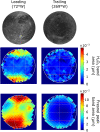Hydrogen peroxide at the poles of Ganymede
- PMID: 37478185
- PMCID: PMC10361591
- DOI: 10.1126/sciadv.adg3724
Hydrogen peroxide at the poles of Ganymede
Abstract
Ganymede is the only satellite in the solar system known to have an intrinsic magnetic field. Interactions between this field and the Jovian magnetosphere are expected to funnel most of the associated impinging charged particles, which radiolytically alter surface chemistry across the Jupiter system, to Ganymede's polar regions. Using observations obtained with JWST as part of the Early Release Science program exploring the Jupiter system, we report the discovery of hydrogen peroxide, a radiolysis product of water ice, specifically constrained to the high latitudes. This detection directly implies radiolytic modification of the polar caps by precipitation of Jovian charged particles along partially open field lines within Ganymede's magnetosphere. Stark contrasts between the spatial distribution of this polar hydrogen peroxide, those of Ganymede's other radiolytic oxidants, and that of hydrogen peroxide on neighboring Europa have important implications for understanding water-ice radiolysis throughout the solar system.
Figures


References
-
- R. E. Johnson, R. W. Carlson, J. F. Cooper, C. Paranicas, M. H. Moore, M. C. Wong, Radiation effects on the surfaces of the Galilean satellites, in Jupiter: The Planet, Satellites and Magnetosphere, F. Bagenal, T. Dowling, W. McKinnon, Eds. (Cambridge Univ. Press, 2004), pp. 485–512.
-
- R. E. Johnson, T. I. Quickenden, Photolysis and radiolysis of water ice on outer solar system bodies. J. Geophys. Res. Planets 102, 10985–10996 (1997).
-
- D. T. Hall, D. F. Strobel, P. D. Feldman, M. A. McGrath, H. A. Weaver, Detection of an oxygen atmosphere on Jupiter’s moon Europa. Nature 373, 677–679 (1995). - PubMed
-
- D. T. Hall, P. D. Feldman, M. A. McGrath, D. F. Strobel, The far-ultraviolet oxygen airglow of Europa and Ganymede. Astrophys. J. 499, 475–481 (1998).
-
- M. A. McGrath, E. Lellouch, D. F. Strobel, P. D. Feldman, R. E. Johnson, Satellite atmospheres, in Jupiter: The Planet, Satellites and Magnetosphere, F. Bagenal, T. Dowling, and W. McKinnon, Eds. (Cambridge Univ. Press, 2004), pp. 457–483.
LinkOut - more resources
Full Text Sources
Miscellaneous

